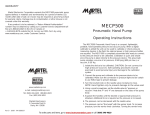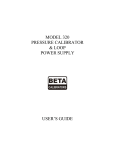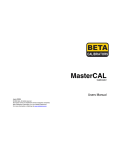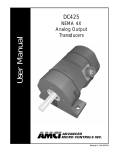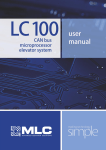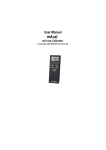Download Martel LC-100 Loop Calibrator Manual PDF
Transcript
LC100 Loop Calibrator Table of Contents 1. Introduction 1.1 Customer Service 1.2 Unpacking . . . . . 1.3 Safety Information 2. Nomenclature . . . . . . . . . . . . . . . . . . . .1 . . . . . . . . . . . . . . . .2 . . . . . . . . . . . . . . . .2 . . . . . . . . . . . . . . . .5 3. Getting Started A. Battery Save Feature . . . . . . . . . . . . . .6 B. HART™ Resistor Setup . . . . . . . . . . . . .6 4. Basic Operating Modes A. Milliamp Source . . . . . . . . . . . . . . . . . .8 B. Milliamp Simulation . . . . . . . . . . . . . . .9 C. Milliamp Measure . . . . . . . . . . . . . . . . .9 D. Milliamp Measure with Loop Power . .10 E. Voltage Measure . . . . . . . . . . . . . . . . .10 5. Advanced Operating Modes A. Auto Step/Ramp Mode . . . . . . . . . . . .11 B. Percent Error Mode . . . . . . . . . . . . . .12 C. Min/Max Datalogging . . . . . . . . . . . . .13 6. Maintenance A. Battery Selection . . . . . . . . . . . . . . . .14 B. Input Protection . . . . . . . . . . . . . . . . .14 C. Calibration . . . . . . . . . . . . . . . . . . . . .14 7. Specifications . . . . . . . . . . . . . . . . . . .15 8. Warranty . . . . . . . . . . . . . . . . . . . . . . . .16 LC100 1. Introduction The Martel LC100 is designed to be a complete 4 to 20mA current calibrator for both troubleshooting and calibrating current loops. Very high accuracy combined with several unique features makes the LC100 an easy to use and highly flexible calibration tool. The LC100 can source, simulate (2-wire) or measure loop currents up to 24mA. It can also measure process signal voltages up to 28VDC with the same 0.015% of reading accuracy. A digital knob user interface combined with decade output control allows the user to make both large or small output changes with ease. Several unique functions such as the autostep/ramp modes allow the LC100 to test valve actuators for smoothness and proper operation. The LC100 can also power two-wire transmitters while simultaneously reading the resultant loop current. All readings are displayed in both milliamps and % of span. 1.1 Customer Service Corporate Office: www.martelcorp.com e-mail: [email protected] Tel: (603) 434-8179 800-821-0023 Fax: (603) 434-1653 Martel Electronics PO Box 770 1F Commons Drive Londonderry, NH 03053 1 Texas Office: www.betacalibrators.com Tel: 800-537-2181 or (972) 241-2200 Fax: (972) 241-2200 Beta Calibrators 2309 Springdale Rd. Farmers Branch, Texas 75234 1.2 Unpacking Remove the packing list and verify that all equipment has been received. If there are any questions about the shipment please call Martel Electronics at 1-800-821-0023. When the shipment is received inspect the container and equipment for any signs of damage. Note any evidence of rough handling in transit. Immediately report any damage to the shipping agent. NOTE: The carrier will not honor any claims unless all shipping material is saved for their examination. After examining and removing contents, save packing material and carton in the event reshipment is necessary. 1.3 Safety information Symbols Used The following table lists the International Electrical Symbols. Some or all of these symbols may be used on the instrument or in this manual. Symbol Description AC (Alternating Current) AC-DC 2 Battery CE Complies with European Union Directives DC Double Insulated Electric Shock Fuse PE Ground Hot Surface (Burn Hazard) Read the User’s Manual (Important Information) Off On Canadian Standards Association The following definitions apply to the terms “Warning” and “Caution”. • “Warning” identifies conditions and actions that may pose hazards to the user. • “Caution” identifies conditions and actions that may damage the instrument being used. 3 Use the calibrator only as specified in this manual, otherwise injury and damage to the calibrator may occur. Warning To avoid possible electric shock or personal injury: • Do not apply more than the rated voltage. See specifications for supported ranges. • Follow all equipment safety procedures. • Do not use the calibrator if it is damaged. Before you use the calibrator, inspect the case. Look for cracks or missing plastic. Pay particular attention to the insulation surrounding the connectors. • Select the proper function and range for your measurement. • Make sure the battery cover is closed and latched before you operate the calibrator. • Remove test leads from the calibrator before you open the battery door. • Inspect the test leads for damaged insulation or exposed metal. • When using the probes, keep your fingers away from the probe contacts. Keep your fingers behind the finger guards on the test leads. • Do not use the calibrator if it operates abnormally. Protection may be impaired. When in doubt, have the calibrator serviced. • Do not operate the calibrator around explosive gas, vapor, or dust. • Disconnect test leads before changing to another measure or source function. • When servicing the calibrator, use only specified replacement parts. 4 • To avoid false readings, which could lead to possible electric shock or personal injury, replace the battery as soon as the battery indicator appears. Caution To avoid possible damage to calibrator or to equipment under test: • Use the proper jacks, function, and range for your measurement or sourcing application. 2. Nomenclature Figure 1 5 3. Getting Started A. Battery Save Feature After unpacking the LC100, it should be ready for use. A 9 volt alkaline battery comes preinstalled. The “Battery Save” feature is enabled and set to 30 minutes in case the unit is accidentally turned on in transit. The battery save feature will turn off the LC100 automatically if no keys are pressed after 30 minutes. To change the length of time on the battery save feature or to disable it completely perform the following steps during power up: 1) Turn off the LC100. AUTO 2) Hold the key down firmly. 3) Turn on the LC100. 4) After power up, wait about 1 second and release the AUTO key. 5) The display will now indicate the amount of time the battery save feature is set for (off to 30 minutes). 6) Using the knob, set the desired time (off to 30 minutes). AUTO 7) Press again to store the value and return the unit to normal mode. The stored value will remain in memory until changed by the operator. B. HART™ Resistor Setup The LC100 incorporates an internal 250 ohm resistor to facilitate using a Rosemount 275 6 Communicator during calibration or installation of HART™ transmitters. The internal resistor takes the place of the 250 ohm resistor normally installed during the use of the model 275 Communicator. An internal jumper can be removed to enable this feature if desired. The unit is shipped with the jumper in place. To remove the jumper open the case and refer to Figure 2 to locate the jumper, then pull off the jumper to enable the resistor. The jumper can be stored outside of the unit or re-installed only on one pin so that the circuit remains open. Figure 2 Note: When the 250 ohm resistor is enabled the load driving capability is reduced from 1200 ohms to 950 ohms. In most cases this should not be a problem when calibrating Non-HART™ compatible products. 4. Basic Operating Modes The LC100 offers 4 modes of milliamp operation and one voltage measure mode. The following text and figures explain the various operating modes: 7 A. Milliamp Source Figure 3 shows a typical application where the LC100 is sourcing 4 to 20 mA into a device under test. Figure 3 - Sourcing 4 to 20 mA 1) Turn on the LC100. It will default to the mA source mode. 2) Connect the device to be calibrated. Warning: The loop must be closed for the LC100 to source current. If an open loop occurs “OL” will flash on the LCD indicating an overload or open condition. 3) The output can be adjusted to the desired value by using the knob interface and selecting the decade to be adjusted. 4) The output can also be stepped in 4 mA steps (25%) using the 8 25% key. 5) The auto step feature provides automated output changes. Refer to the Auto Modes Section of the manual for more information. B. Milliamp Simulation Figure 4 shows how to connect the LC100 to act as a two-wire transmitter using an external power supply. In this application the power for the loop comes from the external supply and the LC100 simply controls the current flow through the loop. The procedure for controlling the output is the same as the milliamp source. Figure 4 - Simulating 4 to 20 mA C. Milliamp Measure Figure 5 shows how to connect the LC100 to measure a 4-20 mA loop. In this application the LC100 is simply reading the loop current and displaying the current in mA on the main display. The lower (smaller) display area is showing percentage relative to a 4 to 20 mA span. 9 D. Milliamp Measure with Loop Power Again, Figure 5 shows the proper connections. But in this case the device under test is a twowire transmitter that requires an external power supply to generate an output current. In this application the LC100 will supply 24 volts to the loop while simultaneously measuring the resultant loop current. To turn on the loop power LOOP PWR supply press the mA measure mode. key while in the Figure 5 - Measuring 4 to 20 mA NOTE: The loop power mode can only be enabled while in the mA measure mode. E. Voltage Measure Figure 6 shows how to connect the LC100 to measure DC voltage up to 28 volts. To activate the volts measure function simply press the MODE key to toggle through the functions until the volts measure mode is reached. The 10 input impedance of the LC100 ≥ 1 meg ohm while in this mode. Figure 6 - Measuring 0 to 28 VDC 5. Advanced Operating Modes A. Auto Step/Ramp Mode The LC100 has the ability to step the mA output in 25% steps automatically in 5 second intervals. It can also ramp the mA output from 4 mA to 20 mA then back to 4 mA in a linear fashion automatically. To activate the Auto-Step/Ramp mode use the following procedure: 1) The Auto Step/Ramp function can be used in either the source mA or simulate mA mode. Place the LC100 in one or the other mode. 2) Connect the LC100 to the device under test. 11 AUTO 3) Press the key once for the step mode, twice for the slow ramp mode and three times for the fast ramp mode. With each press a small annunciator will appear on the lower left side of the LCD indicating which one of the step/ramp modes has been selected. 4) Once enabled the step/ramp mode will run continuously until another key is pressed. B. Percent Error Mode This unique feature will calculate error as a percentage of span (4 mA to 20 mA yields a 16 mA span). The percent error feature allows the user to “Zero Out” the %mA display so that the deviation from the ideal value can be displayed on the % error display. The procedure is as follows: 1) Connect the LC100 to the unit under test. 2) Place the LC100 in one of the mA output modes (source or simulate). 3) Adjust the LC100 to the desired output. 4) If the unit under test does not read exactly as %ERROR it should, hold down the key and adjust the knob unit until the unit under test reads correctly. Continue to hold down the %ERROR key. 5) The reading in the % display area will be the error or deviation calculated as a percentage of span. 12 %ERROR 6) When the key is released the % display will return to normal operation. C. Min/Max Datalogging When the LC100 is in any of the measure modes (mA, mA w/loop power or voltage) it will continuously monitor and store the minimum and maximum values for that particular input mode. To operate the datalogging feature use the following procedure: 1) Place the LC100 in one of the measure modes. 2) Connect the LC100 to the unit under test. 3) Clear the min/max memory by pressing both keys (min and max) simultaneously. The LCD will display “CLR” when the memory is cleared. 4) Allow the unit to log min. and max. for as long as required. Warning: You may want to disable the Battery Save feature before using the Dataloggiong Mode to prevent the LC100 from turning off prematurely. 5) At any time press the min. or max. to display the value stored. 6) Turning off the LC100 or changing modes will clear the memory. Be sure to record your data before turning off the unit. 13 6. Maintenance A. Battery Selection The LC100 operates on a standard 9V alkaline battery or an optional rechargeable 9V Ni-Cd battery. For most applications the 9V alkaline battery will suffice; however, in heavy use applications the 9V Ni-Cd may be a better choice. The 9V Ni-Cd battery supplied by Martel will offer approximately 3 hours of continuous use at 12 mA output on a full charge (the alkaline battery will yield about 12 hours). The charger supplied by Martel will provide an overnight charge rate (10-12 hours) and will also power the LC100 for bench use while maintaining a float charge on the Ni-Cd battery. Warning: Never connect the AC adapter/ charger with the 9V alkaline battery installed. To order the 9V Ni-Cd battery or AC adapter/charger contact Martel Electronics at 800-821-0023. B. Input Protection The LC100 incorporates a fuseless input protection and will tolerate most misconnections up to 250 VAC or 250 VDC for up to 30 seconds duration. Because of this protection no maintenance is required. C. Calibration The LC100 is designed to hold its rated accuracy for a minimum of one (1) year. It is therefore recommend that an annual re-calibration be done to ensure operation within specification. Contact Martel’s Customer Service Department for re-calibration information at 14 1-800-821-0023 or www.martelcorp.com. 7. Specifications Input Range: 0.000 to 24.000 –25.00% to 125.00% Output Range 0.000 to 24.000 Source/Simulate: –25.00% to 125.00% Read VDC: 0 to 30 VDC Accuracy : ±0.015% of reading ±2 counts Resolution: .001 mA; .001 volts Loop Supply Voltage: 24 VDC Typical Drive Capability: 1200Ω w/o Hart 950Ω w/ Hart Auto % Error Function: Yes Selectable Decade Adjustment:Yes Auto Step/Ramp: Yes Preset Outputs: 5 Loop Power Measure Yes Capability: Operating Temperature: –10 to 55°C Power Supply: (1) 9V Battery Rechargeable Battery Option: Yes AC Adapter: Yes Size: 5.7 x 3.15 x 1.43 Weight: 12 oz. 15 8. Warranty Martel Electronics Corporation warrants all products against material defects and workmanship for a period of twelve (12) months after the date of shipment. Problems or defects that arise from misuse or abuse of the instrument are not covered. If any product is to be returned, a “Return Material Authorization” number must be obtained from our Customer Service Department. This number must be indicated on the return package as notice to our Receiving Department to accept the shipment. Any package not so marked will not be accepted and will be returned to the shipper. Martel will not be responsible for damage as a result of poor return packaging. Out of warranty repairs and recalibration will be subject to specific charges. Under no circumstances will Martel Electronics be liable for any device or circumstance beyond the value of the product. 16 www.martelcorp.com e-mail: [email protected] Tel: (603) 434-8179 800-821-0023 Fax: (603) 434-1653 Martel Electronics PO Box 770 1F Commons Drive Londonderry, NH 03053 www.betacalibrators.com Tel: 800-537-2181 or (972) 241-2200 Fax: (972) 241-2200 Beta Calibrators 2309 Springdale Rd. Farmers Branch, Texas 75234 0219053 2/05 Rev D






















